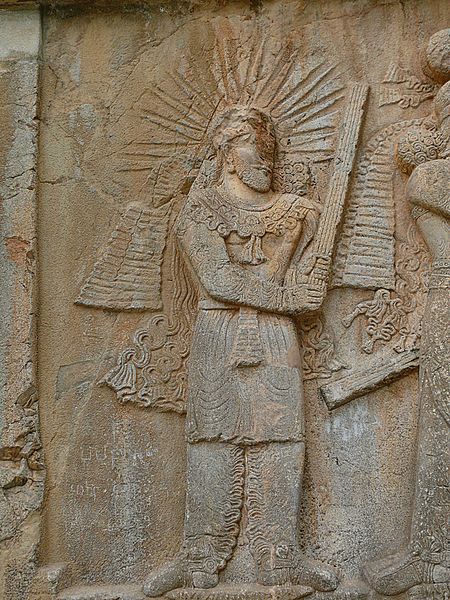File:Mithra (4684713252).jpg

Original file (2,736 × 3,648 pixels, file size: 3.26 MB, MIME type: image/jpeg)
Captions
Captions
Summary
[edit]| DescriptionMithra (4684713252).jpg |
God Mithra on the rock relief of Shapour II at Taq-e Bustan The rock relief of Sasanian king Shapur II (309-379 BCE) at Taq-e Bostan, also known as Taq-e Bustan I shows a double scene of investiture and victory. Shapur II is the first king who ordered the carving of a rock relief at Taq-e Bustan. The reason of such choice may be explained by several facts: a lake is at the footage of the rocky cliff, flooded by several springs, the place is located on a millenniums-used road having linked Babylon to Ecbatan under the Median and later Achemenian era, Seleucia and Hecatompylos under the Parthian, then, Ctesiphon to Kermanshah under the Sasanian ruling. Carved in a rectangular frame, the relief is symmetric, king standing at the center. At the left side, God Mithra emerges from a Lotus flower, crowned by a lightning sun, holding the Barsum (wood bundle symbol of divine power). At the right side, god Ahuramazda wearing his classical crenellated crown gives the king the Farshiang ( ribboned ring symbol of royal power). Under the feet of the king, lay the dead body of Roman emperor Julian the Apostate, who was defeated by Shapur II. The characters are isocephalic ( even Mithra standing above a flower): their heads are on the same level suggesting the king is equal to gods. The relief shows the first representation of a new royal posture: standing frontal body with divergent feet and semi-turned head. Although taken as a whole, the scene looks static, but a detail gives the composition a subtle movement: a closer look at the ring Ahuramazda gives to the king let one see that the god’s hand is closed, holding the ring while the king’s hand is yet open waiting for it. The short angle given to the king's body conjuguated with the rotation of his head & upper body towards Ahuramazda complete the movement. Technically speaking the quality of the carving is very fine, showing that the Sasanian artists have matched a constant progress within time: the depth is clearly increased compared to previous reliefs, while clothes, weapons, crowns, jewels and body details get more realism. Except… The Roman emperor. Leaving aside the realism of his face and clothing reminding those seen on his coinages, Julian the apostate is minimally engraved, with a poor depth, as if the king ordered to suggest a defeated roman enemy was of a lesser importance. The surface of the relief is not smooth, appearing grainy or slightly bumpy. If natural erosion could be an explanation, clues have been found on some Sasanian rock reliefs letting archaeologists think that some reliefs may have been coated with kind of plasters or pigments that could not be applied on smooth surfaces. Taken at Taq-e Bustan, city of Kermanshah, Province of Kermanshah, Iran, May 2009. See also: Rock relief of Shapour II at Taq-e Bustan, frontal view Rock relief of Shapour II at Taq-e Bustan, side view Detail of king Shapur II on his relief at Taq-e Bustan God Ahuramazda on the rock relief of Shapour II at Taq-e Bustan Detail of dead emperor Julian the Apostate on the rock relief of Shapour II at Taq-e Bustan Detail of the lotus flower on the rock relief of Shapour II at Taq-e Bustan |
| Date | |
| Source | Mithra |
| Author | dynamosquito from France |
| Camera location | 34° 23′ 22.15″ N, 47° 07′ 10.83″ E | View this and other nearby images on: OpenStreetMap |
|---|
Licensing
[edit]- You are free:
- to share – to copy, distribute and transmit the work
- to remix – to adapt the work
- Under the following conditions:
- attribution – You must give appropriate credit, provide a link to the license, and indicate if changes were made. You may do so in any reasonable manner, but not in any way that suggests the licensor endorses you or your use.
- share alike – If you remix, transform, or build upon the material, you must distribute your contributions under the same or compatible license as the original.
| This image was originally posted to Flickr by dynamosquito at https://www.flickr.com/photos/25182210@N07/4684713252. It was reviewed on 10 May 2014 by FlickreviewR and was confirmed to be licensed under the terms of the cc-by-sa-2.0. |
10 May 2014
File history
Click on a date/time to view the file as it appeared at that time.
| Date/Time | Thumbnail | Dimensions | User | Comment | |
|---|---|---|---|---|---|
| current | 17:50, 10 May 2014 |  | 2,736 × 3,648 (3.26 MB) | Raso mk (talk | contribs) | Transferred from Flickr via Flickr2commons |
You cannot overwrite this file.
File usage on Commons
There are no pages that use this file.
File usage on other wikis
The following other wikis use this file:
- Usage on ar.wikipedia.org
- Usage on bn.wikipedia.org
- Usage on en.wikipedia.org
- Usage on fa.wikipedia.org
- Usage on fr.wikipedia.org
- Usage on it.wikiquote.org
- Usage on ko.wikipedia.org
- Usage on mg.wikipedia.org
- Usage on ru.wikipedia.org
- Usage on sl.wikipedia.org